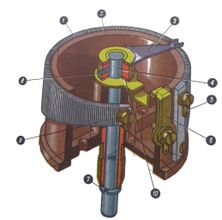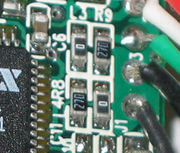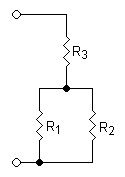Resistor
A resistor is a two-terminal electrical or electronic component that resists an electric current by producing a voltage drop between its terminals in accordance with Ohm's law.
The electrical resistance is equal to the voltage drop across the resistor divided by the current through the resistor. Resistors are used as part of electrical networks and electronic circuits.
Contents |
Applications
The ideal resistor
The SI unit of electrical resistance is the ohm (Ω). A component has a resistance of 1 Ω if a voltage of 1 volt across the component results in a current of 1 ampere, or amp, which is equivalent to a flow of one coulomb of electrical charge (approximately 6.241506 × 1018 electrons) per second. The multiples kiloohm (1 kΩ = 1000 Ω) and megaohm (1 MΩ = 106 Ω) are also commonly used.
In an ideal resistor, the resistance remains constant regardless of the applied voltage or current through the device or the rate of change of the current. While real resistors cannot attain this goal, they are designed to present little variation in electrical resistance when subjected to these changes, or to changing temperature and other environmental factors.
Nonideal characteristics
A resistor has a maximum working voltage and current above which the resistance may change (drastically, in some cases) or the resistor may be physically damaged (overheat or burn up, for instance). Although some resistors have specified voltage and current ratings, most are rated with a maximum power which is determined by the physical size. Common power ratings for carbon composition and metal-film resistors are 1/8 watt, 1/4 watt, and 1/2 watt. Metal-film and carbon film resistors are more stable than carbon resistors against temperature changes and age. Larger resistors are able to dissipate more heat because of their larger surface area. Wire-wound and resistors embedded in sand (ceramic) are used when a high power rating is required.
Furthermore, all real resistors also introduce some inductance and a small amount of capacitance, which change the dynamic behavior of the resistor from the ideal.
Types of resistor
A few types of resistors
Fixed resistors
Some resistors are cylindrical, with the actual resistive material in the centre (composition resistors, now obsolete) or on the surface of the cylinder (film) resistors, and a conducting metal lead projecting along the axis of the cylinder at each end(axial lead). There are carbon film and metal film resistors. The photo above right shows a row of common resistors. Power resistors come in larger packages designed to dissipate heat efficiently. At high power levels, resistors tend to be wire wound types. Resistors used in computers and other devices are typically much smaller, often in surface-mount packages without wire leads. Resistors can also be built into integrated circuits as part of the fabrication process, using the semiconductor material as a resistor. But resistors made in this way are difficult to fabricate and may take up a lot of valuable chip area, so IC designers alternatively use a transistor-transistor or resistor-transistor configuration to simulate the resistor they require.
Construction of a wire-wound variable resistor. The resistive element (1) is trapezoidal, giving a non-linear relationship between resistance and turn angle.
Variable resistors
The variable resistor is a resistor whose value can be adjusted by turning a shaft or sliding a control. They are also called potentiometers or rheostats and allow the resistance of the device to be altered by hand. The term rheostat is usually reserved for higher-powered devices, above about ½ watt. Variable resistors can be inexpensive single-turn types or multi-turn types with a helical element. Some variable resistors can be fitted with a mechanical display to count the turns. Variable resistors can sometimes be unreliable, because the wire or metal can corrode or wear. Some modern variable resistors use plastic materials that do not corrode and have better wear characteristics.
Some examples include:
- a rheostat: a variable resistor with two terminals, one fixed and one sliding. It is used with high currents.
- a potentiometer: a common type of variable resistor. One common use is as volume controls on audio amplifiers and other forms of amplifiers.
Other types of resistors
- A Positive Temperature Coefficient (PTC) resistor is a resistor with a positive temperature coefficient. When the temperature rises the resistance of the PTC increases. PTCs are often found in televisions in series with the demagnetizing coil where they are used to provide a short-duration current burst through the coil when the TV is turned on. One specialized version of a PTC is the polyswitch which acts as a self-repairing fuse.
- A Negative Temperature Coefficient (NTC) resistor is also a temperature-dependent resistor, but with a negative temperature coefficient. When the temperature rises the resistance of the NTC drops. NTCs are often used in simple temperature detectors and measuring instruments.
Identifying resistors
Most axial resistors use a pattern of colored stripes to indicate resistance. SMT ones follow a numerical pattern. Cases are usually brown, blue, or green, though other colors are occasionally found like dark red or dark gray.
One can use a multimeter to test the values of a resistor.
Four-band axial resistor
Four-band identification is the most commonly used color coding scheme on all resistors. It consists of four colored bands that are painted around the body of the resistor. The scheme is simple: The first two numbers are the first two significant digits of the resistance value, the third is a multiplier, and the fourth is the tolerance of the value. Each color corresponds to a certain number, shown in the chart below. The tolerance for a 4-band resistor will be 2%, 5%, or 10%.
The Standard EIA Color Code Table per EIA-RS-279 is as follows:
| Color | 1st band | 2nd band | 3rd band (multiplier) | 4th band (tolerance) | Temp. Coefficient |
|---|---|---|---|---|---|
| Black | 0 | 0 | ×100 | ||
| Brown | 1 | 1 | ×101 | ±1% (F) | 100 ppm |
| Red | 2 | 2 | ×102 | ±2% (G) | 50 ppm |
| Orange | 3 | 3 | ×103 | 15 ppm | |
| Yellow | 4 | 4 | ×104 | 25 ppm | |
| Green | 5 | 5 | ×105 | ±0.5% (D) | |
| Blue | 6 | 6 | ×106 | ±0.25% (C) | |
| Violet | 7 | 7 | ×107 | ±0.1% (B) | |
| Gray | 8 | 8 | ×108 | ±0.05% (A) | |
| White | 9 | 9 | ×109 | ||
| Gold | ×0.1 | ±5% (J) | |||
| Silver | ×0.01 | ±10% (K) | |||
| None | ±20% (M) |
Note: red to violet are the colors of the rainbow where red is low energy and violet is higher energy.
Resistors use specific values, which are determined by their tolerance. These values repeat for every exponent; 6.8, 68, 680, etc. This is useful because the digits, and hence the first two or three stripes, will always be similar patterns of colors, which make them easier to recognize.
Preferred values
Resistors are manufactured in values from a few milliohms to about a gigaohm; only a limited range of values from the IEC 60063 preferred number series are commonly available. These series are called E6, E12, E24, E96 and E192. In practice, the discrete component sold as a "resistor" is not a perfect resistance, as defined above. Resistors are often marked with their tolerance (maximum expected variation from the marked resistance). On color coded resistors the color of the rightmost band denotes the tolerance:
- silver 10%
- gold 5%
- red 2%
- brown 1%.
Closer tolerance resistors, called precision resistors, are also available.
5-band axial resistors
5-band identification is used for higher tolerance resistors (1%, 0.5%, 0.25%, 0.1%), to notate the extra digit. The first three bands represent the significant digits, the fourth is the multiplier, and the fifth is the tolerance. 5-band standard tolerance resistors are sometimes encountered, generally on older or specialized resistors. They can be identified by noting a standard tolerance color in the 4th band. The 5th band in this case is the temperature coefficient.
Mnemonic phrases for remembering codes
There are many mnemonic phrases used to remember the order of the colors.
They are, but are not limited to, and variations of:
- Bad Boys Ravish Our Young Girls But Violet Gives Willingly
- Bad Beer Rots Our Young Guts But Vodka Goes Well. Get Some Now!
- B.B. ROY of Great Britain had a Very Good Wife
- Buffalo Bill Roamed Over Yellow Grass Because Vistas Grand Were God's Sanctuary
Black Brown Red Orange Yellow Green Blue Violet Gray White (Gold Silver)
Calculations
Ohm's law
The relationship between voltage, current, and resistance through a metal wire, and some other materials, is given by a simple equation called Ohm's Law:
- V = IR
where V (or U in some languages) is the voltage (or potential difference) across the wire in volts, I is the current through the wire in amperes, and R, in ohms, is a constant called the resistance. (In fact this is only a simplification of the original Ohm's law - see the article on that law for further details.) Materials that obey this law over a certain voltage or current range are said to be ohmic over that range. An ideal resistor obeys the law across all frequencies and amplitudes of voltage or current.
Superconducting materials at very low temperatures have zero resistance. Insulators (such as air, diamond, or other non-conducting materials) may have extremely high (but not infinite) resistance, but break down and admit a larger flow of current under sufficiently high voltage.
Power dissipation
The power dissipated by a resistor is the voltage across the resistor multiplied by the current through the resistor:
All three equations are equivalent. The first is derived from Joule's law, and other two are derived from that by Ohm's Law.
The total amount of heat energy released is the integral of the power over time:
If the average power dissipated exceeds the power rating of the resistor, then the resistor will first depart from its nominal resistance, and will then be destroyed by overheating.
Series and parallel circuits
Resistors in a parallel configuration each have the same potential difference (voltage). To find their total equivalent resistance (Req):
The parallel property can be represented in equations by two vertical lines "||" (as in geometry) to simplify equations. For two resistors,
The current through resistors in series stays the same, but the voltage across each resistor can be different. The sum of the potential differences (voltage) is equal to the total voltage. To find their total resistance:
A resistor network that is a combination of parallel and series can sometimes be broken up into smaller parts that are either one or the other. For instance,
However, many resistor networks cannot be split up in this way. Consider a cube, each edge of which has been replaced by a resistor. For example, determining the resistance between two opposite vertices requires matrix methods for the general case. However, if all twelve resistors are equal, the corner-to-corner resistance is 5/6 of any one of them.
Technology
Wirewound resistors are commonly made by winding a metal wire around a ceramic, plastic, or fiberglass core. The ends of the wire are soldered to two caps, attached to the ends of the core. The assembly is protected with a layer of paint, molded plastic, or an enamel coating baked at high temperature. The wire leads are usually between 0.6 and 0.8 mm in diameter and tinned for ease of soldering.
Types of resistors:
- Carbon composition
- Carbon film
- Metal film
- Metal oxide
- Wirewound (usually has higher parasitic inductance)
- Cermet
- Phenolic
- Tantalum
Foil resistor
Foil resistors have had the best precision and stability ever since they were introduced in 1958 by Berahard F. Telkamp. One of the important parameters influencing stability is the temperature coefficient of resistance (TCR). Although the TCR of foil resistors is considered extremely low, this characteristic has been further refined over the years.



